Bridgeward
Club, St Peter's Vicarage, Tragedy of Lady Milbank
An enquiry from Lisa Smith in January 2018
initiated this page.

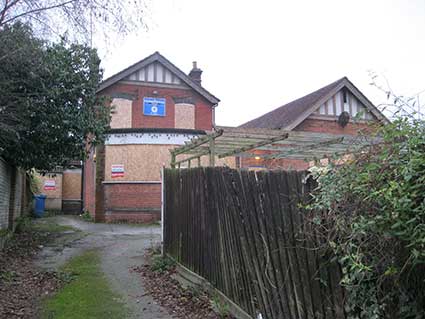 2018 images
2018 images
Tucked away behind the houses in Austin Street, Over Stoke is
the Bridgeward (otherwise Bridge Ward, after the electoral division)
Social Club. At the time of our visit, the shuttering gates happened to
be open, so these photographs could be taken.

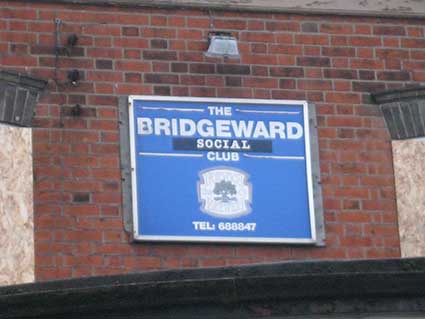
We understand the the club is scheduled for demolition and the
site used for housing.
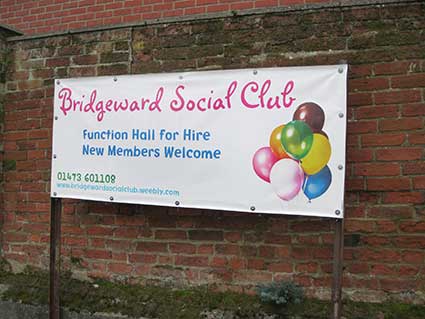
However, Lisa sent the following email, map and photograph.
'Hello Borin. I've attached a plan of the 'Bridge Ward Conservative
Club' as it became known at some point in it's history... I was having
building work carried out in my garden when builders came across a
cellar. It turns out that I'm living on top of what was St Peter's
Vicarage... The picture was part of a much larger panorama of the town
taken from the Rectory Road area of the town. The Liberal
Club/Conservative/Bridge Ward Club would be situated directly to the
left of the Vicarage. From other papers I have I think the vicarage was
demolished somewhere around 1925 [see
the last passage at the bottom of the page]. Looking at the
picture again today, and considering the date, I'm now wondering if the
very faint image to the top left is the Ipswich Union Workhouse. If so,
this is the first picture I have ever seen of it.'
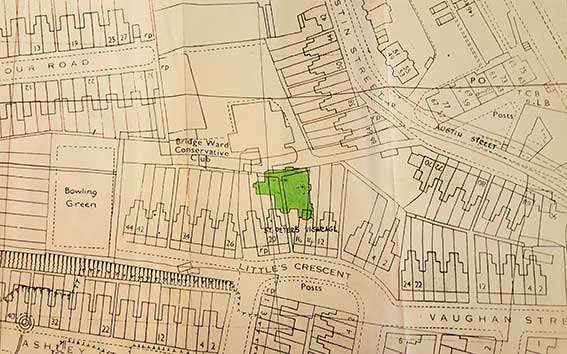 undated
map
undated
map
The map confirms that, as some period, the club was claimed by
the Conservatives. The 1920s map of the location shows
that Vaughan Street ran only as far as Pauline Street and the houses
which were to make up Little's Crescent were only partially completed.
The most interesting features to note, as pointed out by Marcus
Bateman, are the Bridgeward Club (labelled here 'Club') and the
remaining part of the Vicarage of St Peter – probably less than half of
the footprint shown above in green. It also indicates that the green
shape must predate the 1920s. Perhaps the vicarage was demolished
in stages.
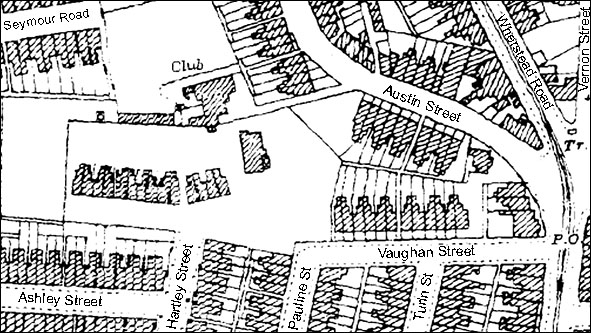 1920s map
1920s map
The 1904 map detail below shows the vicarage, clearly labelled, with
the club building to the north-west and surprisingly close to it. The
large gardens with trees and oval driveway are shown with carriage
access into Austin Street quite close to the Vernon Street junction
(where the first Co-op store in Ipswich had
been opened in 1878). The corner building is Uncle Tom's Cabin public
house, whose first listed licencee was in 1871. The area round the
vicarage was being closely built on with terraced housing by the 1920
map above.
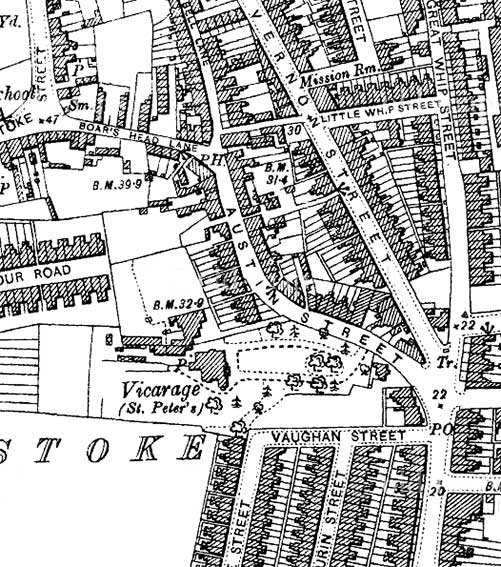 1902
map
1902
map
Is the ghostly shape to the left of the vicarage in the photograph
below the Ipswich Union Workhouse
which once stood on Great Whip Street/Felaw
Street? Great Whip Street Union Workhouse was
a substantial set of buildings which operated on that site from 1837 to
1899 with 400 inmate spaces. The Union Workhouse moved to
Heathfields (today's hospital site) and ran from 1899 to 1930 with a
similar number of spaces. See the
update below for another opinion.
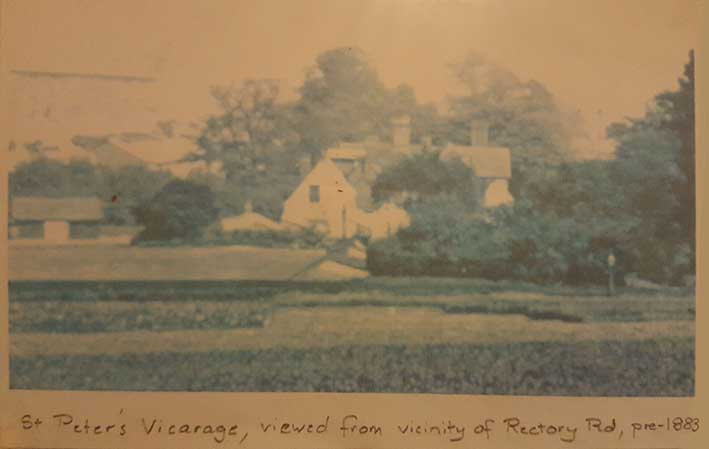 pre-1883
photograph
pre-1883
photograph
[UPDATE 16.2.2019: 'No
new information I’m afraid. I was just musing over the Bridgeward Club
page of the your excellent website (www.ipswich-lettering.co.uk/bridgewardclub.html)
and wonder if the St Peter’s Vicarage photo is actually from the south,
looking north, and that the large building in the background is the
Eastern Union Mills building on the north side of the river. Looking at
the 1883 OS map, the vicarage had outbuildings to the west of the main
house and it may be these that are visible in the photo. Also, the
ghostly building in the photograph looks enormous, was the workhouse
really that tall? Just a thought. Regards, Mark Sommers.' Thanks, Mark – more investigation required.]
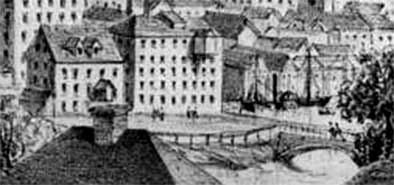 Eastern
Union Mills, 1850
Eastern
Union Mills, 1850
This detail from an illustrated view of the town from Stoke Hill c.1850
(found on the Mills Archive Trust website) shows the Eastern Union
Mills at the centre, with the tide mill at the left and Stoke Bridge at
lower right; a steamer is moored at St Peter’s Wharf above the bridge.
The height of the mills building (five storeys to the roofline,
punctuated by teagle doors) is notable. Whether this would have been
visible from south of the vicarage, given the rise in the land on the
Stoke side, can be discussed.
An aerial view shows how closely the original club building –
the flat-roofed extensions will be more recent – is built to the
neighbouring gardens. Presumably the asphalt car park was once a garden
and bowling green – a press article from 1901 reports the annual dinner
of the Bridge Ward (Ipswich) Liberal Club Bowling Club.
Below is a detail from Joseph
Pennington's map of 1778 showing the early nucleus of Over Stoke
village. At this time, because of the angled driveway coming off Austin
Street (see Street name derivations for
the source), the building in red must be the vicarage of St Peter –
only a modest stroll accross Stoke Bridge
from the church itself, show at top centre. The vicarage is set in
meadows and open land to the south, nearer to the Church of St
Mary-At-Stoke than the Church of St
Peter.
The map shows a period when the tide mill adjacent to the bridge
was in operation, the pool of St Peter's Wharf was larger than today
and long before the construction of New Cut and the enclosed Wet Dock
in 1842.
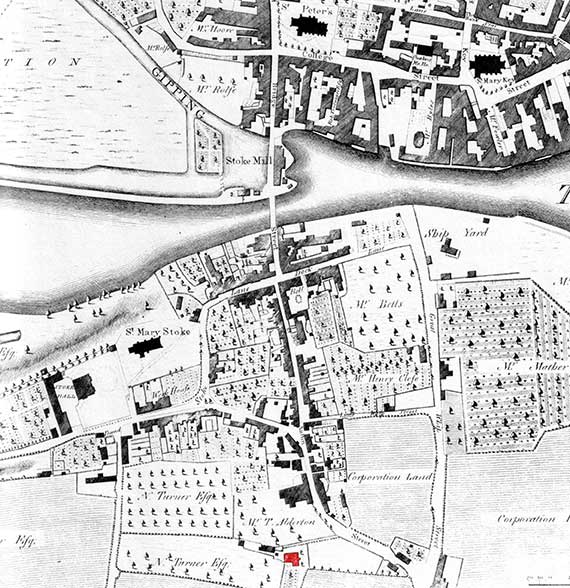 1778
map
1778
map
The detail below from Edward White's map
of 1867 shows a wider view of the area to include the recently laid out
Rectory Road at lower left to show the suggested viewpoint for the
pre-1883 photograph of the vicarage, which indicates that the ghostly
image to the left is, indeed the elevation of the Union Workhouse in
the near-distance. New Cut, the island and the Wet Dock have
transformed the eastern part of the map, the mill is still visible and
Commercial Road runs horizontally from the left, running into St
Peter's Quay and Albion Quay on the dockside. On the Over Stoke side,
Dock Street now runs round into Stoke Quay and the housing resulting
from the Industrial Revolution is increasing in density and spread.
Note particularly the terraces lining Station Street and Croft Street
(labelled 'Halbert Street' in 1867).
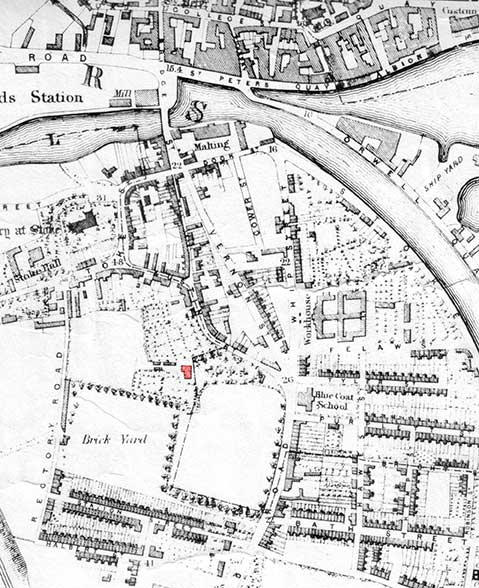 1867 map
1867 map
Larger versions of this map detail can
be found on our Stoke Hall page and our Brickyards page.
Who lived at the vicarage?
Census return 1871
shows Rev. Alex H. Synge (50) and family living at the Vicarage; born
Dublin Ireland.
Including:
Georgina (Wife, 40); born Nottingham;
Three daughters, one son, one Governess;
Brother of Georgina, Clement J. Cobb (44), Vicar of St Georges Barnsley;
Sister of Georgina, Mary J. Cobb (37);
Sister of Alex, Julia Synge (47);
Four Domestic servants.
Census return 1881
shows Rev. R.A. White and family living at the Vicarage:
AustinStreet (The Vicarage, St Peter).
Richard Allen White. Head. Married. 40. Vicar of St Peters Ipswich.
[Where born] Wexford Ireland;
Octavia
M.
. Wife
37.
Suffolk;
Maurice R.L. .
Son.
. 5.
Scholar
“ ;
Richard F.
.
Son.
. 3.
-
“ ;
Alice Mary Taylor . Governess
. 26. Governess
plus Cook, Housemaid, Nursemaid.
Within a ten year period the Church of St Peter had two Irish
vicars. Mr Synge's 1871 household seems to have been very full with a
number of sibling residents (including another vicar). Rev.
White is credited in The Ipswich
Journal 1 December 1877 with 'very energetic' efforts in
fund-raising for the resoration of the church and a personal donation
of £200 to clear the church's debts.
By 20 May 1884 this advertisement appeared in the East Anglian Daily Times:
‘Messrs. GARROD, TURNER and SON
ST. PETER’S VICARAGE, IPSWICH.
On WEDNESDAY, the 21st May, 1884, at Three o’clock in the Afternoon
precisely,
GARROD, TURNER and SON will SELL by AUCTION, by direction of the Rev.
R.A. White, who has left Ipswich, a few articles of FURNITURE,
including 3 settee chairs to attach and form a central ottoman, 3 iron
bedsteads, mattresses, a suite of bedroom furniture, perambulator,
&c.
OUT-DOOR EFFECTS, including lawn mower, garden tools, greenhouse and
bedding plants, bee-hives, side saddle, carpenter’s bench, Wheelbarrow,
boardsand trestles.
Two GLASS HOUSES, one detached and one lean-to, pit lights, &c.
Catalogues may be had of the AUCTIONEERS, 1 Old Butter Market, Ipswich.’
[For a later view of the Garrod
Turner & Son offices at this address, see our Giles page.]
The Club
By at least 20 July 1901 (Evening
Star item) the Bridge Ward Club appears to have been active,
although it is not clear what had happened on the site since the sale
of vicarage furniture in 1884.
A flavour of the Liberal attitudes to women can be gained from this
opening passage from a report in the East Anglian Daily Times, 21
February, 1894:
‘IPSWICH WOMEN’S LIBERAL ASSOCIATION.
There was a gathering of between 300 and 400 members of the Westgate
and Bridge Wards of the Ipswich Women’s Liberal Association at the
annual Ward tea at the Co-operative Hall on Tuesday evening. After the
tea the members were many of them [sic] joined by their husbands, and
the Co-operative Hall was well filled when Canon Bulstrode took the
Chair. The rev. gentleman was supported on the platform by Mr. R.D.
Fraser, Mr. John Pratt, Mr. W.F. Paul, Mr. H.W. Raffle, together with
several ladies including Mrs. R.D. Fraser, Mrs. W.O. White, Miss
Oxborrow, Mrs. John Pratt, Mrs. W.F. Paul, Miss Butler, Mrs.
Bloomfield, Miss Scopes, Mrs. Bulstrode, with the hon. sec. of the
Association, Mrs. W.O. Owen. A forcible speech was delivered by Mr.
Geake, of the Eighty Club, who described in detail the measures passed
through the House of Commons during the present session; most of them
unfortunately had not become law, though they had been approved by the
representatives of the people…’
We can draw from the above text that, at the height of the
Victorian period – and when the suffrage movement divided opinion on
many sides – Liberal organisations welcomed women to most of their
functions: 'Ladies cordially welcomed'. However, the chairing of
meetings and many of the speakers were prominent males such as wealthy
businessman and philanthropist W.F. Paul (who founded his Tenement
Trust, dealt with on our More almshouses
page).
Reading through the early press coverage of the Bridge Ward Club, it is
clear that it was once a popular and well-attended centre of the
community. Sadly, by the 21st century numbers had fallen to the extent
that the club is slated for demolition.
Many thanks to Lisa Smith for sending material about the
vicarage and club.
Vicarage and Club together
It would be tempting to think that the Bridge Ward Club replaced
the Vicarage on the site, but Lisa Smith sent the following information:
'The census returns for 1901 show William Mayes as Steward of the
Liberal Club and Rev. William Shepphard at the Vicarage and both listed
at Austin Street. William Sheppard seems to have some involvement in
education.
The census for 1911 still shows William Mayes at the Liberal Club and
Rev. William Francis Kerr at the Vicarage and still listed under Austin
Street. The two properties must have been touching one another!
On the Ipswich War Memorial Project website [see Links]
there is an entry for Edward Bournes Kerr ( and picture) who was the
son of William and who was killed in World War I (memorial in St
Peter's Church) . This site lists William Kerr as 'Rector of St Peter
1911-1919.'
The Lady Milbank incident
Star of the East, Friday Evening, September 2, 1887:
SERIOUS ACCIDENT TO LADY MILLBANK.
On Thursday afternoon an accident, resulting in serious injury to Lady
Susan Millbank, of Stutton Hall, a friend and a groom, occurred at
Stoke, Ipswich. As Lady Millbank was driving a tandem past Stoke
School, the groom sitting behind, the horse apparently shied at a
wheelbarrow which was standing near the School, and bolted along the
street. Lady Millbank was unable to hold the animal in, it being a very
hard-mouthed one, and the groom attempted to do so. Having no foothold,
however, he also failed, and the horse ran at a furious pace until it
got to the top of Bell Lane. Here the carriage came in contact with a
cart standing on side of the road, and going to the other side it
overturned onto a brewer’s dray standing opposite at the New Anchor
Inn*. The concussion was very severe, and the horse broke away from the
carriage, dragging one of the traces with it. The horse harnessed to
the dray also ran away, and the carriage fell on its side on the
ground, on top of Lady Millbank. Assistance was speedily at hand, the
vehicle was raised, and the injured persons extricated. Lady Millbank
and her friend were taken to St. Peter’s Rectory, where they were seen
by Drs. W.A. Elliston and Station (who remained with them two hours).
As far as they could ascertain no bones were broken, but her ladyship’s
knee was very badly injured. Up to a late hour they were still at the
rectory. The groom, whose name was William Thompson, aged 37, was taken
to the hospital, where it was found that it was he was very severely
injured about the head and collar-bone.
As soon as the horse got loose it ran off in the direction of Sutton
Hall, and had got as far as the Ostrich Inn [Wherstead] before it was
stopped. In its mad career it managed to stamp on the loose trace and
turned a somersault. The carriage was not much damaged.’
[*New Anchor Inn, 1 Austin St. The pub is also listed as the Anchor, at
33 & 35 Bell Lane in 1861. In 1861 it's listed at 33 & 35 Bell
Lane, next to Little Wonder at 29 & 31 on the opposite side of road
to the Good Intent. (Another Anchor is listed at 1 & 3 Bell Lane in
1861, with the Old Bell [unnamed] probably listed at 2 & 4 Dock
Street.) It seems likely it's been demolished, though we don't have a
concrete location yet. The closure date is recorded in the Borough
Police licensed premises register 1903-1923. Information from Suffolk CAMRA, see
Links]
Norwich Mercury, September 7,
1887:
‘SUFFOLK.
MISS MILLBANK, of the Chestnuts, Stutton, near Ipswich, who was injured
in a carriage accident at Ipswich on Thursday last, died on Monday
afternoon from injury to the spine.Her death took place at St. Peter’s
Vicarage, Ipswich, where she was conveyed after the accident.’
Our contributor writes:
‘I’ve since found references to this accident in other papers – The Western Daily Press, The Ipswich Evening Star, The Daily Gazette For Middlesborough,
The Huddersfield Chronicle, The Derby Daily Telegraph, The Sheffield Daily Telegraph, The Western Morning News, The Dundee Courier, The Leeds Times, The Manchester Courier and The Lancashire General Advertiser…
I have no idea who the Millbanks are/were or why news of the accident
appeared in so many newspapers but it's a strange feeling being able to
pin down a specific event in time to an exact location and know that
you are sitting in the middle of it!’
The Stutton connection
‘Regarding the family of Milbank, to my knowledge at no time did they
live in Stutton Hall. Godolphin Milbank and his wife moved into
the "Chestnuts”, now named Stutton Lodge, in August 1890. They were
still there in 1900 but left before 1924. We have two marked graves in
St Peters Churchyard, one for Harriet C. Milbank, born 1870 died
1887. The other for Susan Georgiana Godolphin Milbank, died 1903
age 73. We have no information on Lady Susan in 1887, and very little
about the family. I hope this will be of help, and should any
information come to light, I will pass it on to you. Any information or
photos you have on the family will be of interest to our Group and much
appreciated. Let me know if I can help with any other information. Kind
Regards. Vic Scott, Stutton Local History Research Group.’
Many thanks to Vic for the
information.
Home
Please email any comments and contributions by clicking here.
Search Ipswich
Historic Lettering
©2004 Copyright throughout
the Ipswich Historic Lettering site: Borin Van Loon
No reproduction of text or images without express written permission

 2018 images
2018 images


 undated
map
undated
map 1920s map
1920s map 1902
map
1902
map pre-1883
photograph
pre-1883
photograph Eastern
Union Mills, 1850
Eastern
Union Mills, 1850 1778
map
1778
map 1867 map
1867 map